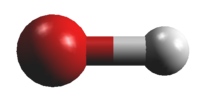Oxoniumylidene, hydroxylium, X 3Σ–
 | |
|---|---|
| Species tag | 017501 |
| Version | 2* |
| Date of Entry | Jan. 2016 |
| Contributor | H. S. P. Müller |
|
New v = 1 – 0 infrared data with megahertz
were included in the initial fit to improve the first
entry from Apr. 2003. Details of the new fit as well as
the data are presented in | |
| Lines Listed | 430 |
| Frequency / GHz | < 19339 |
| Max. J | 22 |
| log STR0 | -15.0 |
| log STR1 | -15.0 |
| Isotope Corr. | -0.0 |
| Egy / (cm–1) | 0.0 |
| µa / D | 2.256 |
| µb / D | |
| µc / D | |
| A / MHz | |
| B / MHz | 492346.31 |
| C / MHz | |
| Q(300.0) | 78.4249 |
| Q(225.0) | 59.2924 |
| Q(150.0) | 40.2006 |
| Q(75.00) | 21.1872 |
| Q(37.50) | 11.8145 |
| Q(18.75) | 7.4677 |
| Q(9.375) | 6.1172 |
| Q(5.000) | 5.9993 |
| Q(2.725) | 5.9960 |
| detected in ISM/CSM | yes |